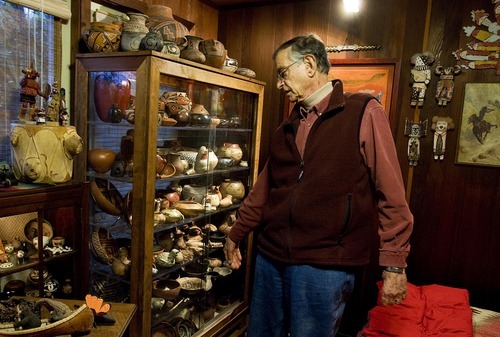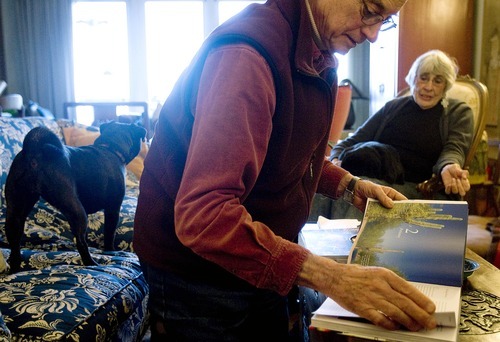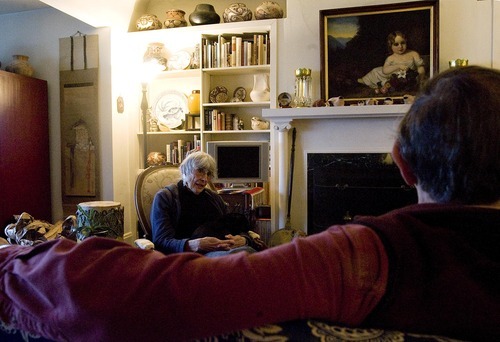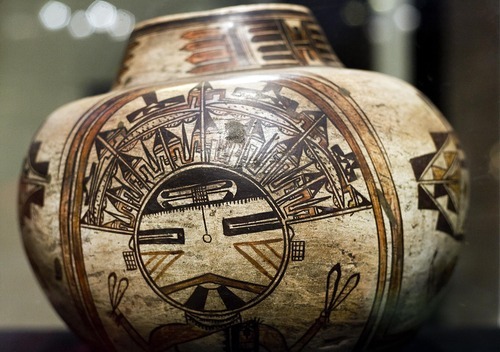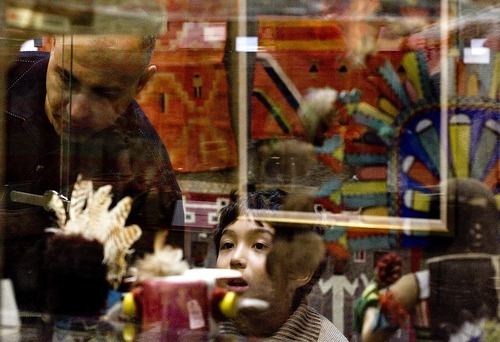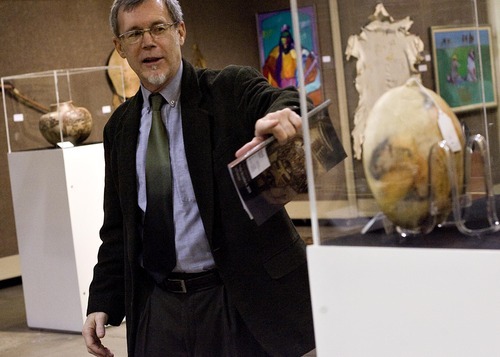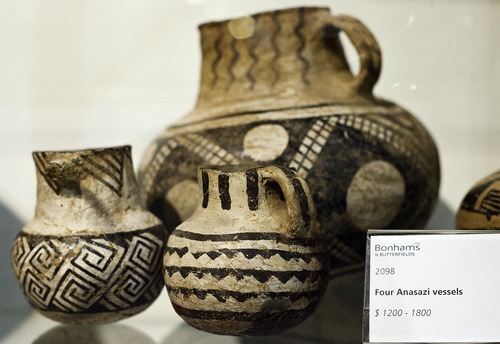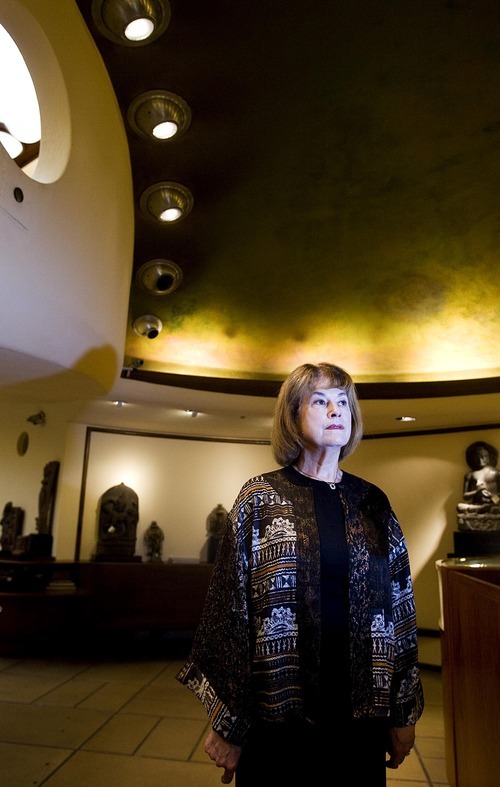This is an archived article that was published on sltrib.com in 2010, and information in the article may be outdated. It is provided only for personal research purposes and may not be reprinted.
San Francisco • Nabil Haidar shepherds his two young sons around the Bonhams & Butterfields auction house showroom, staring through glass cases into history. And prehistory.
Ancient pottery, the San Jose, Calif., cop says, tells a story of its people. Buckskin or feather clothing is a window into this continent's old ways.
"When it's in your home and you touch it," Haidar says, "it's like, 'Wow. So many generations.' If only it had a mouth to speak, it could tell you what it's gone through."
There is a reason people dig up artifacts in places such as southern Utah's Ancestral Puebloan ruins, target of a 2009 crackdown on looting from public lands. American Indian relics are big business in metropolitan America, Europe and beyond, often fetching thousands of dollars per piece at auction houses. Anasazi art is just a tiny potsherd in the puzzle, but it draws intense interest from history buffs.
It's perfectly legal if the items come from private lands or from private collections predating federal antiquities law. Still, buyers at auction candidly say that they are worn down by government scrutiny and aren't so keen on Ancestral Puebloan pieces. Ancient Southwestern pottery is still for sale and certified legal, but many say they don't want to invite a hassle.
"You worry about it," says Dan Hidding, an Illinois collector looking for pottery during one of two preview days before a Dec. 6 sale here. He no longer buys or sells Anasazi pots, except among people he knows and trusts.
"But I'll tell you, this whole thing is ridiculous," he says.
—
"Gotcha" • The "thing" is the 2009 arrests of alleged Four Corners gravediggers and artifacts traffickers, accused of either unearthing relics from protected federal or tribal lands or selling them to an undercover operative.
Hidding supports the Native American Graves Protection and Repatriation Act. But he says the government is overzealous in using it, the Archaeological Resources Protection Act and the Antiquities Act in harassing collectors.
"There seems to be a great glee in 'I gotcha,' " he says. He believes the crackdown is partly because professional archaeologists are overly possessive, wanting to dig everything themselves. And, like other collectors and dealers, he says there is too much deference to spiritual items that may actually have been produced for sale.
"Digging up graves? No," he says. "But a kachina doll? Theoretically, it has spiritual value, but so does a cross. Who's to say it's sacrilege?"
An artifact at market might come with a long written history — its provenance — assuring its legal status. Dealers agree this is an imprecise art, based partly on trust among their tight network, and law agents acknowledge that once a relic is out of the ground, it's virtually impossible to trace.
Retired federal prosecutor Wayne Dance, who specialized in Utah archaeology cases, says he understands the trepidation. Proving origins is difficult unless a landowner vouches for the artifact, he says, and investigators have documented cases of fraudulent papers. The opacity works both ways, though, because it essentially takes a criminal admission to prove illicit ownership once an item is moved.
"It's a gray area," Dance says of provenance.
Bonhams & Butterfields requires sellers to sign a contract testifying to their legal possession of an item.
Haidar, a first-generation Lebanese-American whose wife is part Cheyenne, isn't here for the ancient stuff. With an eye for Plains Indian goods, he looks for stealth buys that elude big spenders. His target: a painted animal skin labeled as a Crow pictograph and estimated to be worth $6,000 to $9,000. On it are 19th-century U.S. cavalrymen in battle with Indians. Apart from the fray is a dignified Indian on horseback.
"This gentleman is a chief?" Haidar asks. "What's his status? What does it mean? It tells you a story. It's not just a drawing."
He speaks with a hushed but energized reverence.
Once you buy a relic, he says, you must read everything you can about it and its people. The more you learn, the more you buy.
—
Eyes on the prize • Across the warehouse showroom are shelves of Southwestern pottery, including some black-on-white Ancestral Puebloan pots. The ancient ones aren't the most sought-after here, and most pieces are expected to go in the $1,000 to $2,000 range.
Hidding, president of a plastics injection molding company in Arlington Heights, Ill., is admiring them. He is a collector with about 1,000 pieces of American Indian art, mostly pots, jewelry and woven items. He rose at 6 a.m. to catch a flight from Chicago's O'Hare International Airport for this Saturday viewing and will return home by midnight. He will bid by phone Monday.
He is impressed with the checkered prehistoric pottery.
"Beautiful works of art," he says.
But he's here for the singular prize of this auction, a bulbous Hopi jar painted in kachina-doll designs by a renowned artist named Nampeyo, active in the early 20th century. Flamboyant black and burnt-umber headdresses adorn stylized faces on four sides of the pot.
It belonged to late Chicago Mayor Carter Harrison Jr., who had donated it for display at that city's Cliff Dwellers art club in the 1930s. The auction catalog predicts bids ranging from $60,000 to $90,000. Hidding sees some collectors he knows from his 35 years of doing this, and he is sure they will bid up the Nampeyo jar. He approaches one of them and jokes about his fears of being put to shame come Monday.
Some collectors of high-end art don't like disclosing what they have at their homes, and Hidding makes it clear he won't talk Monday if his phone bid takes the pot. He doesn't want people to know about the best pieces he already owns, either.
Ancient pottery is, at auction, "low on the totem pole," muses Jim Haas, director of pre-Columbian and tribal art at Bonhams & Butterfields.
News of raids in the Southwest, both last year and in the 1990s, has diminished interest in the items, he says. He's not aware of prices plunging during his 26 years here, though he rarely sees much of it offered and has included only a handful of Anasazi pieces in this auction.
"[It's] just because of news that would suggest that this is an area rife with potential problems," Haas says. "Any kind of negative press suppresses demand."
Age is not the only consideration in American Indian art's value, he says. Elegance and utility also play roles. "That's part of the appeal of Native American art," he says. "A handmade object in the days of digital. ... There's an extra bit of soul attached."
—
Passion led to book • Across the Golden Gate Bridge, in the swank seaside village of Sausalito, Allan and Carol Hayes are also planning for the auction. The collectors, who, like many enthusiasts, have become dealers out of their home, specialize in Southwestern pottery. They aren't likely to bid on much, they say, because they are expecting high rollers. But they will view the goods Sunday and then make an appearance at Monday's auction.
The Hayeses got into this almost accidentally, picking over cheap contemporary pottery while vacationing in Santa Fe., N.M. But soon they upgraded.
After a chance meeting with a salvage archaeologist who dug on private land in Arizona, they vacationed there and bought older pieces fresh from the ground. They later invited a friend, John Blom, and went back to buy legally dug and documented pots.
"The buying frenzy was on," says Allan Hayes, a retired advertising art director. Each piece opened a new and wondrous chapter of native culture. "I said, 'John, we either have to stop doing this, or we have to write a book to justify the habit.' "
In 1996, they wrote Southwestern Pottery: Anasazi to Zuni, a beginner's guide that remains in print.
The Hayeses swelled their collection to hundreds of pieces, old and new. Clay pots line the shelves in the living room of their comfy hillside home and also fill cubbies in rooms throughout, with a tall display rack in a downstairs den. This is their passion. Only about a third of what they own is for sale.
"We're collectors first," Carol Hayes says.
They rarely buy or sell Anasazi pots. Like Hidding, they say it isn't worth the possible entanglements. But it matters little. Allan Hayes says the Southwest's Puebloan potters are now in a golden age, and the key for him is to celebrate the culture, current or prehistoric.
He is frustrated with a government clampdown that he sees as harming those with a valid interest in history. He accepts that it's hard to know whether a pot's provenance is legitimate, though he demands a seller'spapers.
"I have no illusions whatever that none of them have been laundered," he says, but "we bought ethically."
The Hayeses aren't sure about Blanding, the southern Utah site of most of last year's looting arrests. But they have come to know dealers and collectors in Santa Fe, and they believe some were unfairly targeted. Agents searched the homes and shops of a few Santa Fe collectors but didn't indict them.
"They just think everybody's crooked," Carol Hayes says.
"We're trying to tell the world about Native American heritage," Allan Hayes says, "and it bothers us that the government is trying to build a wall between knowledge of their heritage and the rest of the world."
On Monday, about 60 bidders sit in a dozen rows of chairs, in a long, narrow room with brown carpet on the walls and gray on the floor. Above them is a handful of big-screen TVs picturing the items from the nearby viewing room. Many bidders dress in Western garb: bolos and boots, turquoise and coral zigzags on black shirts. A woman wears a fringed leather jacket.
Auctioneer Wes Sparling chants about a set of Apache cloth dancing masks until the bidding stops at $2,800. Soon, a Pueblo shield with horns painted on a semicircle ups the ante, starting at $12,000 and quickly rising to $18,000.
"Fair warning at $18,000," Sparling intones. "Last chance at $18,000," and he raps his podium, indicating a sale.
Buyers bid by raising numbered placards to shoulder or face height. Phone bidders have auction employees on the line doing it for them. A Tlingit pipe from Southeast Alaska fetches $40,000.
—
$350,000 • A couple of hours pass. As some buyers mill about a table of croissant sandwiches and coffee, the coveted Hopi jar appears on the screen. It starts at $20,000 but quickly reaches $70,000, causing a murmur in the crowd. At $100,000, there's a wave of laughter, and the bidding shifts from the floor to the phones. At $200,000, someone yells, "All right, baby." At $260,000, the Hayeses lean their heads together in comic disbelief.
"Anyone want to steal the show at $280,000?" Sparling asks.
Yes. A caller bids $280,000, only to be beaten by a final phoned offer of $290,000.
After adding an auction premium, the sales price is $350,000. Bonhams & Butterfields declares it a world record for Southwest American Indian pottery.
The bidding all day is too rich for the Hayeses, who nonetheless are briefly reunited with old friends from New Mexico. The Ancestral Puebloan pottery, as expected, goes in the low thousands.
"It's Anasazi," beams John Warnock as he leaves toting a handled black-on-white jar with a pattern of spiraling squares. A resident of Los Altos, Calif., he has a summer home in Deer Valley and a collection that graced a Utah Museum of Fine Arts exhibition last year.
"It could well be from Utah," he says of the jar.
Haidar, here alone this time, changes targets. He decides the Crow pictograph is out of his price range. He bids instead on a Sioux rawhide parfleche container, painted in red, blue and yellow diamonds and set off by green, blue and yellow dashes. He wins it for $3,050. He cannot wait to show his sons, age 8 and 5.
"We'll just mount that on the dining-room wall," he says, smiling wryly. "Then we do our dance and light the fire and send the boys out on a hunting trip."



